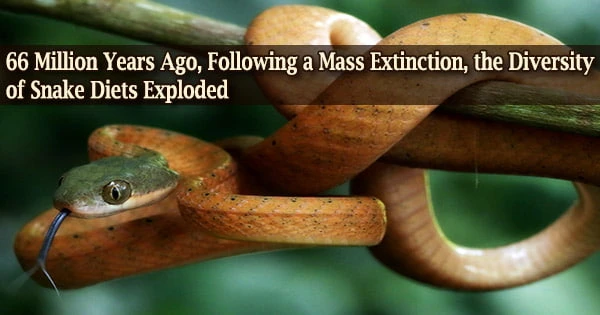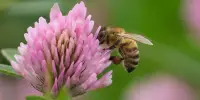The progenitors of modern snakes presumably mostly consumed insects and lizards while coexisting with dinosaurs.
Then, 66 million years ago, a miles-wide asteroid wiped out around three-quarters of the planet’s plant and animal species, including nearly all of the dinosaurs. This paved the way for the early Cenozoic Era’s dramatic diversification of mammals and birds.
According to a recent study from the University of Michigan, early snakes took advantage of the ecological opportunity and the abundance of available prey by rapidly and repeatedly evolving innovative dietary adaptations and prey preferences.
The work will be published online on October 14 (2021) in the journal PLOS Biology and combines genetic data with ecological knowledge gleaned from preserved museum specimens.
“We found a major burst of snake dietary diversification after the dinosaur extinction species were evolving quickly and rapidly acquiring the ability to eat new types of prey,” said study lead author Michael Grundler, who did the work for his doctoral dissertation at U-M and who is now a postdoctoral researcher at UCLA.
At that time, snake diets started to include mammals and birds, which were also diversifying in the wake of the extinction. Additionally, specialized diets have developed, such as snakes that solely consume slugs, snails, or lizard eggs.
Similar bursts of nutritional diversity were also observed when snakes entered new regions, such as the New World.
“What this suggests is that snakes are taking advantage of opportunities in ecosystems,” said U-M evolutionary biologist and study co-author Daniel Rabosky, who was Grundler’s doctoral adviser. “Sometimes those opportunities are created by extinctions and sometimes they are caused by an ancient snake dispersing to a new land mass.”
According to Grundler and Rabosky, the frequent transformative changes in nutritional ecology were significant catalysts for the emergence of a wide range of novel forms that were adapted for various environments and modes of life, or what evolutionary biologists refer to as adaptive radiation.
A lot of the stories of evolutionary success that make it into the textbooks such as Darwin’s famous finches are nowhere near as impressive as some groups of snakes. The dipsadines of South and Central America have just exploded in all aspects of their diversity, and yet they are almost completely unknown outside the community of snake biologists.
Michael Grundler
With more than 3,700 species worldwide, snakes in the modern era exhibit incredible diversity. The diets of these snakes are also incredibly diverse, ranging from tiny leaf litter snakes that only eat invertebrates like ants and earthworms to enormous constrictors like boas and pythons that feed on animals as large as antelope.
So, how did legless reptiles that can’t chew come to be such important predators on land and sea?
Grundler and Rabosky initially put together a dataset on the diets of 882 species of contemporary snakes to find out.
More than 34,000 actual observations of snake diets are included in the dataset, as well as data from the study of the stomach contents of preserved museum specimens and published accounts of scientists’ fieldwork with snakes. The U-M Museum of Zoology, which houses the second-largest collection of reptiles and amphibians in the world, provided many of those specimens.
All currently existing species are descendants of previously extinct species. However, because to the scarcity of snake fossils, it is difficult to directly observe the origins of modern snakes and their evolutionary relationships.
But those connections are still present in the DNA of snakes that are still alive. That genetic data can be retrieved by biologists, who can then utilize it to create what they refer to as phylogenies family trees.
In a new mathematical model, Grundler and Rabosky combined their nutritional dataset with previously released snake phylogeny data to determine the characteristics of long-extinct snake species.
“You might think it would be impossible to know things about species that lived long ago and for which we have no fossil information,” said Rabosky, an associate professor in the U-M Department of Ecology and Evolutionary Biology and an associate curator at the Museum of Zoology.
“But provided that we have information about evolutionary relationships and data about species that are now living, we can use these sophisticated models to estimate what their long-ago ancestors were like.”
The new study not only demonstrated a significant boom in snake dietary diversification after the extinction of the dinosaurs during the so-called K-Pg mass extinction, but it also demonstrated similar rapid dietary modifications when groups of snakes entered new areas.
For instance, when the Colubroidea superfamily of snakes migrated to the New World, some of the quickest rates of dietary change, including an increase of about 200% for one subfamily, took place.
The majority of the current diversity of snakes in the globe may be found in the colubroid family, which has species on every continent but Antarctica. All poisonous snakes are included in this group, along with the majority of other well-known snakes. Boas, pythons, and a few uncommon snakes, like pipe snakes and blind snakes, are excluded.
Additionally, Grundler and Rabosky discovered that the rate at which snakes adapt to new diets is incredibly variable. For tens of millions of years, certain populations, like blind snakes, continued to evolve slowly and ate primarily ants and termite larvae.
On the other end of the spectrum are the more than 700 species of dipsadine snakes, a sizable subfamily of colubroid snakes. According to the latest study, they have gone through a continuous surge of dietary diversification since arriving in the New World around 20 million years ago.
Goo-eaters, false water cobras, forest flame snakes, and hognose snakes are some of the dipsadines. Many of them, sometimes referred to locally as false coral snakes, mimic dangerous coral snakes to fend off predators.
“In a relatively short period of time, they’ve had species evolve to specialize on earthworms, on fishes, on frogs, on slugs, on snakelike eels even other snakes themselves,” Grundlersaid.
“A lot of the stories of evolutionary success that make it into the textbooks such as Darwin’s famous finches are nowhere near as impressive as some groups of snakes. The dipsadines of South and Central America have just exploded in all aspects of their diversity, and yet they are almost completely unknown outside the community of snake biologists.”
Rabosky and Grundler emphasized that without the knowledge gained from conserved museum specimens, their work would not have been possible.
“Some people think that zoology collections are just warehouses for dead animals, but that stereotype is completely inaccurate,” Rabosky said. “Our results highlight what a tremendous, world-class resource these collections are for answering questions that are almost impossible to answer otherwise.”
Funding for the study was provided by the National Science Foundation and the David and Lucile Packard Foundation.
















